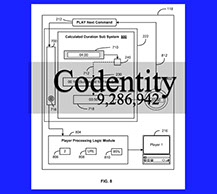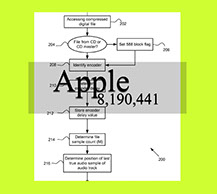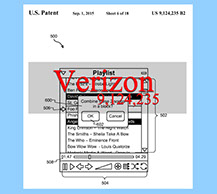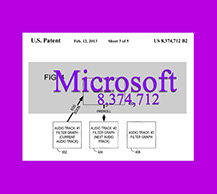Gapless Playback Methodologies
There are as many as one hundred instances of patent applications or granted patents relating to the field of digital audio transitioning.
When you compare the difference in disclosed methodologies, it is possible to understand WHY and HOW the teachings of the Codentity patent (U.S. 9,286,942) produce outcomes that consistently surpass the capabilities of methods deployed by other applicants.
How the OTHER Companies Execute Gapless Playback Methodology
The patent designs for many of the well-known technology companies typically produce some type of simulated gapless playback effect. Their methods generally use various forms of DSP (digital signal processing).
Examples include: frame sampling, buffer blending, filter-graphing, waveform analysis, pre-roll calculations, or file comparisons. These processes require CPU overhead, and can create transition pairings with imprecise song boundaries and undesirable audio levels.
Unfortunately, their outcomes (depending on the vendor and the song-pairings) are often not what the listener would expect to hear. So, as ingenious as some of the other marketplace designs may be, the Codentity® patent seeks to improve the listener experience by disclosing a system and methods that are more pleasing, more efficient, and more consistent.
Methodology Typically Utilized in OTHER Gapless Playback Implementations

The 'gapless playback' methods of Codentity®, Apple®, Microsoft®, and Verizon® are very different—TAP or CLICK images to read patents

See LIST of 'gapless playback' patents


CTT does NOT produce cross fades
CTT does NOT cause content portion deletions
CTT does NOT compare song attributes
CTT does NOT use audio frame sampling
CTT does NOT use frame buffering
CTT does NOT use frame blending
CTT does NOT use filter-graphing
CTT does NOT use pre-roll techniques
CTT does NOT use meta tag analysis
CTT does NOT use song-pair analysis
CTT does NOT use delay techniques
CTT does NOT use any form of synchronization
CTT does NOT use single-player quantization blending
CTT does NOT require significant CPU resources
CTT does NOT 'flush' (empty) a processing buffer
- Cross fades
- Content deletions
- Song attribute comparisons
- Frame sampling
- Frame buffering
- Frame blending
- Filter-graphing
- Pre-rolls
- Meta tags
- Song-pairing
- Delays
- Synchronization
- Quantization
- CPU overhead
- Buffer flush
on receiving a MANUAL command to start next song
(because this causes immediate insertion of a SILENCE GAP in the music stream)
Codentity® Gapless Playback Methodology Is Different
Codentity® Transition Technology (CTT) is a patented method (US 9,286,942) which creates a song measurement, content duration calculation, and multi-player execution system. CTT enables consistent audio levels as it alternates song playback between two or more media players, producing an unending series of uniformly natural, overlapping or adjoined transitions between songs.
With Codentity® Transition Technology, this mixing magic is accomplished automatically—in real time—without latency, pre-rolls, filter-graphing, or delays. And with CTT, there is no requirement for user actions like song preparation, tag assignment, level editing, or input of global or discrete fade points.
Codentity® Transition Technology delivers a more pleasing listener experience because (unlike with other methods) there are no silence gaps, no premature fade-outs, no unwanted fade-ins, and no song-content portion deletions. The result is song rendering the way the artist intended, and music flow the listener expects.
Learn more about INTEGRATION SUPPORT for Codentity® Transition Technology on your platforms.
See how the OTHER guys implement 'gapless playback'. See LIST of companies with 'gapless playback' patents.
Codentity® Transition Technology can be LICENSED and adapted to improve the music-flow experience for your devices and platforms. Ready to learn more? Go to the licensing FAQ page.
How Codentity® Gapless Playback Methodology Works
The patented methods of Codentity® Transition Technology take a more fundamental approach. Here is a simplified* explanation:
- At play time, CTT starts rendering a first song (i.e., audio file) in a first independent media player.
- Simultaneously with the start of the first song, CTT makes a total duration measurement (in milliseconds) for the rendering song, and stores this value in special memory space.
- Then, CTT uses a logic assessment to determine whether the rendering (i.e. playing song) ends with a gradual fade out or an abrupt (cold) style.
- CTT will next use the logic style assessment to determine which of (at least two) predetermined and stored intervals will be used in a mathematical operation pertaining only to the currently rendering song.
- Next, CTT subtracts the logic selected predetermined and stored time interval from the total duration measurement of the first song. This operation produces the calculated “creative content” duration of the rendering first song.
- In a sub-step, and co-incidental with the start of the first song, the calculated “creative content” duration (in milliseconds) of the rendering song is assigned to a hidden programmatic timer object.
- CTT starts the timer object (within milliseconds of the calculated “creative content” duration assignment).
- When the timer object countdown reaches zero, a command is given by the system to start a second song in a second independent media player.
- The continuous audio output streams of each independent media player are mixed (i.e., concurrently played) by the system, and heard by the listener as either overlapped or adjoined (i.e., tightly abutted).
- The process repeats, without a requirement for user action, until the playlist is exhausted.
*The simplified explanation of the Codentity® LLC patent methodology is a condensed representation. It is not meant to replace the actual language of the granted patent; the limitations of which are solely determined by the metes and bounds of the patent (US 9,286,942):
Automatic calculation of digital media content durations optimized for overlapping or adjoined transitions
©2023 CODENTITY LLC